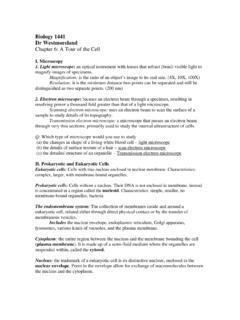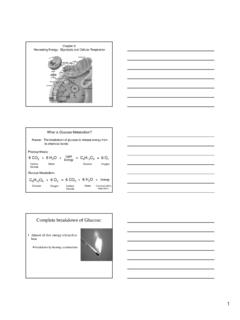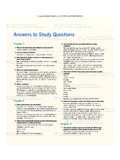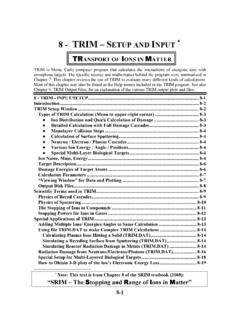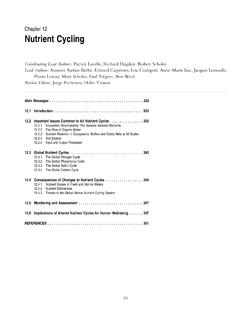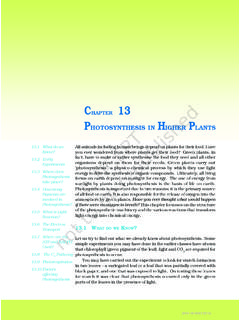Transcription of Chapter 6 ELECTRON TRANSPORT - Stony Brook University
1 Chapter 6. ELECTRON TRANSPORT . P. B. Allen 1. INTRODUCTION. A voltage gradient ( rF E) drives an ELECTRON current (j sE; where s is the conductivity). Many mechanisms of ELECTRON TRANSPORT are known. (1) Electronic quasiparticle propagation, the rst known mechanism, studied by Drude [1], and improved by Sommerfeld [2,3], Bloch [4], Landau [5], and others. The current is given by eX. j vk F k (1). V k where F k is the distribution function ( the non-equilibrium occupation) of the quasiparticle state k (short for: k; n; s) which has energy k and group velocity vk @ k =@ _k ; and V the sample volume. (2) Quasiparticle tunneling through barriers. (3) Supercurrent ow in superconductors. The (Landau Ginzburg) order param- p . eter is c nS exp if ; and the current, with no magnetic eld, is 2e _.
2 JS c rc crc 2enS _rf=m (2). 2mi where it is assumed that the super uid density nS is spatially uniform. (4) Intrinsically diffusive currents in dirty alloys, metallic glasses, etc. (5) Hopping currents in dilute ELECTRON systems where states are localized by (i). trapping at localized defects, (ii) Anderson localization at band tails in disor- dered media, or (iii) polaronic self-trapping in insulators. Contemporary Concepts of Condensed Matter Science Conceptual Foundations of Materials: A Standard Model for Ground- and Excited-State Properties Copyright r 2006 Published by Elsevier ISSN: 1572-0934/ (06)02006-3. 165. 166 P. B. Allen (6) Separate propagation of charge and spin in 1D metals ( Luttinger liquids''). (7) Collective sliding of charge-density waves when incommensurate distortions open a gap in a metal.
3 This article will focus on examples where mechanisms can be clearly identi ed. Two other constraints are imposed. First, magnetic eld effects (Hall effect, magneto- resistance, etc.) are excluded, for no good reason except to allow room for other things. Second, if an effect (like Anderson localization, or weak localization''). occurs in 3d bulk materials, and occurs in lower dimension in altered form, then only the 3d version is included here, for the same reason. TRANSPORT is a subject of greater breadth and depth than can be covered in any one volume, let alone Chapter . Thanks rst to mesoscopic'' physics, and now, to nanoscience,'' the eld of TRANSPORT is rapidly expanding and evolving. This chap- ter has three aims. First, to illustrate the breadth and beauty of the subject. Second, to illustrate how techniques from electronic structure theory are used to explain or predict values of TRANSPORT coef cients such as electrical resistivity.
4 Third, to guide a reader through some of the theoretical notions currently evolving as nanoscale research changes the way we think about these things. 2. CONDUCTIVITY. The conductivity s is the usual starting point. Let there be an electric eld varying slowly in space and sinusoidally in time, E t E cos ot : Then a bulk solid will respond to rst order with an electrical current j a t s 1 2 . ab E b cos ot sab E b sin ot (3). To simplify, the tensor notation sab will often be condensed to s with implicit rather . than explicit tensor aspects. Equation (3) is equivalent to j t Re s o Ee iot ;. with a complex conductivity s s 1 is 2 whose real and imaginary parts denote in-phase (dissipative) and out-of-phase (reactive) response to the E eld. I will use the standard Fourier conventions Z 1 Z 1.
5 Do E t E o e iot and E o dtE t eiot (4). 1 2p 1. to relate time to frequency; j t and s t have the same connection to j o and s o : Since j t and E t are real, and since j o s o E o ; it is necessary that E o obey E o E o and similarly for j o and s o : The time-domain relation between j and E is Z 1. j t dt0 s t t0 E t0 (5). 1. Thus, s t has the meaning that it gives the current at time t in response to an impulsive unit E- eld E t0 d t0 : Causality'' is the statement that if E t is zero until it is turned on'' at time t 0; then j t must also be zero for times to0: Thus ELECTRON TRANSPORT 167. R 1vanish for negative t; from which the Fourier relation Eq. (4) becomes s t must s o 0 dts t exp iot : Now let us regard s o as a function of a complex o: When Im o 40 (that is, in the upper half o-plane) the integral converges abso- lutely, permitting interchange of derivative and integral from which follows @s1 =@o1 @s2 =@o2 and @s1 =@o2 @s2 =@o1 : These are the Cauchy Riemann equations which con rm that s o is analytic in the upper-half o-plane.
6 This is the basis for the Kramers Kronig integral relations between real and imaginary part of s o for real o: Consider the Drude formula [1], originally proposed on classical grounds, for the conductivity of metals: ie2 n=m eff sDrude o (6). o i=t The factor n=m eff is discussed later, see Eqs. (26) and (55). For simple metals, n=m eff is fairly close to n=m; where n is the valence ELECTRON density and m the free ELECTRON mass. The ELECTRON charge is e: Unlike these parameters with xed clas- sical meaning, t is a phenomenological parameter indicating the time between the collision events which allow electrons to reach a steady-state current. Note that s o has a pole at o i=t; that is, in the lower part of the complex o-plane. By Fourier inversion we nd n . sDrude t e2 e t=t y t (7). m eff where y t is the unit step function, zero for to0 and 1 for t40: The real part of s(o) is a Lorentzian, with conserved spectral weight Z 1 Z 1.
7 2 n 2 ntotal dos 1 . Drude o pe but dos 1 . exact o pe (8). 1 m eff 1 m Both of these are unaffected by the phenomenological parameter t: The second version, for the exact s; is the f -sum rule.'' It is equivalent to the statement that s t 0 ; which is the current just after a unit pulse E t d t has been applied, is given by the classical constant ntotal e2 =m; where ntotal includes core as well as valence electrons, and the integral includes ultraviolet and x-ray regions of the spectrum. In the limit of an in nitely sharp pulse and zero elapsed time, electrons have not yet responded to anything other than the E- eld. They do not notice the positive nuclei or the Coulomb repulsion with each other. Thus the sum rule is true for any system, molecule or extended, insulator or metal, crystal or glass.
8 Now consider the experimental results [6] for copper, the prototype ordinary metal, shown in Fig. 1. The dielectric constant'' o is de ned by 1 4pP=E. where the polarization P is related to current j by j @P=@t: Therefore, we have o 1 4pis o =o; and 2 4ps 1 =o: The Drude Lorentzian, centered at o . 0; has a strength measured in terms of the Drude plasma frequency'' o2P . 4pe2 n=m eff : Theory [7] gives _oP 9:1 eV: This can be compared with the free ELECTRON value, eV, which is based on a simpli ed model of 1 rather than 11. valence electrons per Cu atom. The Drude part of s o becomes quite small for 168 P. B. Allen Fig. 1. Measured optical properties of Cu metal at three temperatures [6]. Interband tran- sitions set in above 2 eV. At lower frequencies, the tail of the Drude part varies with tem- perature.
9 The inset is a schematic of the real part of the Drude conductivity s o ; Eq. (6) at three temperatures. photon energies _o as high as 2 eV. At higher photon energies, s1 increases, indicating additional non-Drude currents, which are caused by electrons making quantum transitions from d-states not far below the Fermi energy E F into s-states above the Fermi energy, with a conserved wavevector k: The f -sum Eq. (8) is approximately divided into spectral weight in the Drude region below 2 eV, and spectral weight from interband transitions. As temperature T changes, the spectral weight in the Drude region is conserved. The formula for n=m eff needs a treatment of the energy bands, discussed in Section from a quantum approach, and then discussed again from a semiclassical point of view in Section Although the interband part of s o is normally classi ed as optical properties'' rather than TRANSPORT ,'' nevertheless, there is no truly fundamental distinction, and under- standing of low-o TRANSPORT requires some understanding of high-o behavior.
10 3. CONDUCTANCE VERSUS CONDUCTIVITY: THE POINT. CONTACT. For homogeneous bulk matter, the electrical properties are characterized by the intrinsic conductivity s 1=r of the material. For other cases, conductance G . 1=R is the appropriate parameter. Figure 2 illustrates the reason. ELECTRON TRANSPORT 169. (a) (b). A. V D. Fig. 2. (a) The usual four probe geometry for measuring resistivity of a bulk material. The voltmeter draws negligible current and thus does not disturb the electrical potential distri- bution. (b) An idealized ori ce of diameter D in an otherwise bulk sample. For D small compared with the sample dimensions, the resistance is dominated by the alteration of electrical potential in the vicinity of the ori ce. This is a model for a point contact.''. In the usual bulk case, the conductance is G sA=L where s is an intrinsic property, A the cross-sectional area of the conductor, and L the length.

